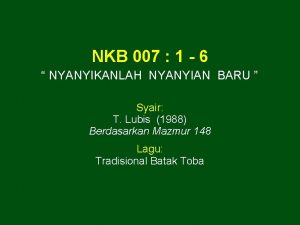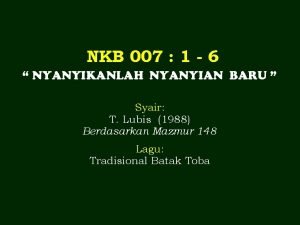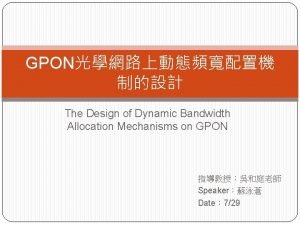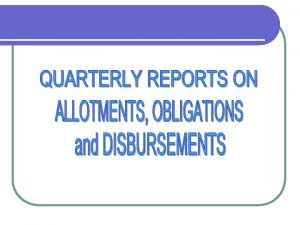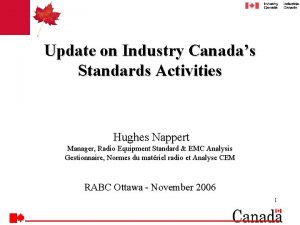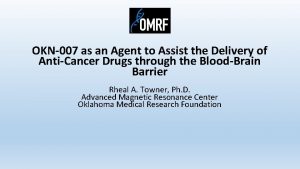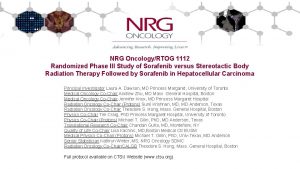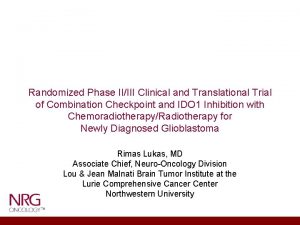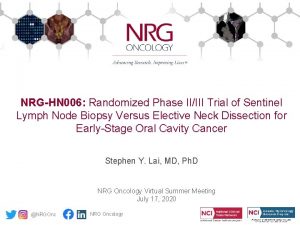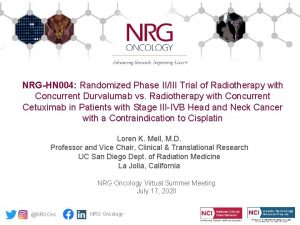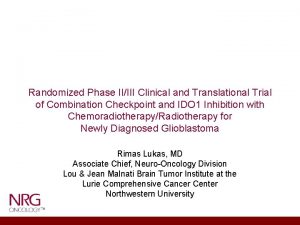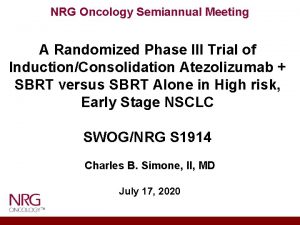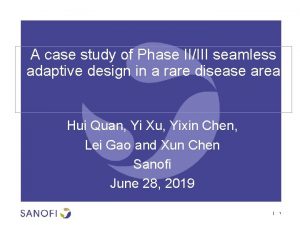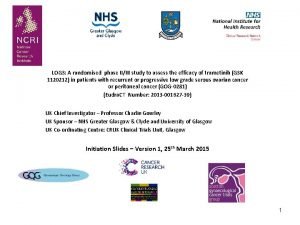NRG LU 007 Randomized phase IIIII study of















- Slides: 15

NRG LU 007: Randomized phase II/III study of EP + Atezo +/- consolidation RT for ESSCLC (RAPTOR) Quynh Nguyen M. D. Associate Professor, Department of Radiation Oncology James Welsh M. D. Associate Professor, Department of Radiation Oncology John Heymach, M. D. , Ph. D. Chair, Dept. of Thoracic/Head and Neck Medical Oncology David Bruton, Jr. Chair in Cancer Research NRG July 17, 2020

Rationale for the study • Chest RT prolongs PFS, improves 2 Y survival, and reduces chest recurrences by more than 50% when given after chemo in ES SCLC in patients with non-PD, and is considered a SOC 1 – Data suggests RT to extrathoracic sites may provide additional benefit • Atezo+EP followed by atezo is now a standard for ES SCLC • Atezo+chemo can be given safely with chest RT for stage 3 NSCLC (Deterred study 2) • Pembro + RT can be given safely for ES SCLC (Tames study 3) • RT may enhance efficacy of PD 1/PD-L 1 blockade 1. Slotman et al. , Lancet 2015 2. Lin et al. , JTO 2019 3. Welsh et al. , JTO 2019

Slotman 2015 Role of thoracic RT in ES-SCLC 2009 to 2012 498 ES-SCLC pts - PS 0 -2 - Any response to EP - “acceptable” radiation fields - no brain, pleural mets, or LMD Stratified by: 1) Institution (42) 2) +/- intrathoracic disease R a n d o m i z e PCI + Thoracic RT 30 Gy/10 fx n=247 PCI alone n=248 Primary endpoint - Overall survival @ 1 yr - Intention-to-treat Secondary endpoints - Local control - Pattern of failure - PFS - Toxicity All patients: 1) PCI (20 Gy/5 fx, 25 Gy/10 fx, 30 Gy/10, 12 or 15 fx) 2) Cis/Etoposide x 4 -6 cycles “in accordance with local policy” 3) Chemo response not centrally reviewed 4) 7% of patients were ES by bulk of intrathoracic dz alone Slotman BJ et al; Lancet 2015

Clinical outcome for TRT in ESSCLC OS PFS 2 yr OS: 13% TRT vs 3% control (p=0. 004) PFS at 6 months was 24% TRT vs 20% no TRT group (p=0. 001) Secondary analysis showed < 3 sites distant metastases experienced largest benefit TRT Thoracic radiotherapy in addition to prophylactic cranial irradiation should be considered for all patients with ES-SCLC who respond to chemotherapy Slotman BJ et al; Lancet 2015

Phase I trial of pembrolizumab plus RT after induction chemotherapy for ES SCLC (TAMES 1) Part B ES SCLC after first line platinum chemo (up to 6 cycles) -PCI allowed N=33 evaluable Thoracic radiation + Pembro Q 3 w TRT 15 fx, 45 Gy, boost allowed Adjuvant pembro Results: -Well tolerated -No grade 4/5 SAE -6% with GR 3 (astenia, paresthesia, autoimmune AE) -median PFS 6. 1 m (CI 4. 1 -8. 1) -median OS 8. 4 m (CI 6. 7 -10. 1 m) 1. Welsh et al. , JTO 2019

IMPOWER 133: the addition of atezolizumab to carbo/etoposide prolongs OS and PFS in ES SCLC Median OS was 12. 3 months in the atezo group and 10. 3 months in the placebo group (HR=0. 70; 95% CI, 0. 54 to 0. 91; P=0. 007) Median PFS was 5. 2 months in the atezo group and 4. 3 months in the placebo group (HR=0. 77; 95% CI, 0. 62 to 0. 96; P=0. 02) Atezolizumab + carboplatin/etoposide consistent with previously reported safety profile Horn et al. , NEJM 2018

Proposed NRG-LU 007 RAPTOR: RAndomized Phase II Trial of Consolidation Radiation + Immunotherapy for ES-SCLC with SD/PR after 4 -6 cycles of carbo/cis + etoposide + atezolizumab Phase II: N=138 Phase III: N= 324 total (including phase II patients) PRIMARY ENDPOINTS: 1. Phase II: PFS 2. Phase III: OS R* Arm 1: XRT up to 5 RT sites, 30 -45 Gy + atezolizumab Atezolizumab maintenance Q 3 W Arm 2: Atezolizumab maintenance Q 3 W • Stratified: # RT sites (1 -3 fields vs >3), partial response (PR) vs stable disease (SD), ECOG (0/1 vs 2) • PCI optional with consolidation, MRI after induction chemo, co enrollment SWOG S 1827 encouraged • Can radiate symptomatic sites prior enrollment (i. e. bone mets, or WBRT) Nguyen/Welsh/Heymach

Proposed NRG-LU 007 RAPTOR study: endpoints Primary Endpoints: • Phase II: to PFS between RT vs control arms, N=138 • Phase III: To compare OS between RT vs control arms, N=324 Secondary Endpoints: • Toxicity • PFS and OS benefit in subgroups with 1 -3 vs >3 tumors and RT all visible sites some visible sites Statistical plan • Phase II: improvement of 6 m PFS rate from 21% to 38% to warrant continuing to phase III • Phase III: 80% power to detect an improvement in 12 m OS rate from 51% to 63% at 1 -sided significance level of 0. 025

Proposed NRG-LU 007 RAPTOR study: exploratory endpoints Exploratory: • Association between pre-treatment tumor burden and PFS and OS benefit with treatment • PFS benefit in low and high blood tumor mutational burden (TMB) subgroups • Association between pre-treatment plasma ct. DNA levels and clinical benefit • Changes in T cell repertoire induced by radiotherapy • *Association between SCLC molecular subgroups and clinical benefit (in development).

Inclusion criteria • • Pathologically proven diagnosis of ES-SCLC PR or SD after 4 -6 cycles of carbo/cis + etoposide + atezolizumab within 9 weeks of last dose of chemotherapy or 6 weeks from completion of PCI Patients must have had measurable disease (RECIST) after chemotherapy and prior to randomization and 3 or fewer observable liver metastases Imaging include MRI brain with contrast or Brain CT with contrast, CT chest, abdomen and pelvis, or PET/CT scan after the final cycle of chemotherapy + 6 wks prior to registration Pleural effusion if thoracentesis is negative of if too small sample w/thoracentesis or PET/CT negative Age ≥ 18 ECOG Performance Status of 0 -2 at the time of registration Laboratory values within 14 days prior to registration • • ANC ≥ 1, 500/cells/mm 3 Platelets ≥ 100, 000 cells/mm 3 Hemoglobin ≥ 8 g/d. L Total Bilirubin ≤ 1. 5 x ULN AST (SGOT) and ALT (SGPT) ≤ 3. 0 x ULN (AST and/or ALT ≤ 5 ULN for patients with liver involvement) Alkaline phosphatase ≤ 2. 5 × ULN (≤ 5 ULN for patients with documented liver involvement or bone metastases) Adequate renal function: serum creatinine ≤ 1. 5 x ULN

Exclusion criteria • Metastatic disease invading the liver (>3 metastases), pleura, heart or >10 metastatic sites after induction systemic therapy • Prior thoracic or mediastinal radiation or metastatic site region of study • Prior invasive malignancy – (except non-melanomatous skin cancer) unless disease free for 5 year prior to randomization) • History of autoimmune disease – (including systemic lupus erythematosus, inflammatory bowel disease, vascular thrombosis associated with antiphospholipid syndrome, Wegener’s granulomatosis, Sjögren’s syndrome , Guillain-Barré syndrome, multiple sclerosis, vasculitis, or glomerulonephritis). • Severe co-morbidity – (severe liver, renal, COPD, cardiac morbities) • History of recent myocardial infarction • History of allogeneic organ transplant • Patients who have had immunotherapy induced pneumonitis.

Radiation Technique • 3 D-Conformal Radiation (3 DCRT) or Intensity Modulated RT (IMRT) allowed, Image Guided Radiation Therapy (IGRT) is required. • Standard RT up to 5 lesions in thorax, liver, bone, spine, abdomen/pelvis, soft tissue.

Assessments During treatment Pre-treatment Assessments Within 14 days prior to registration After the last cycle of CT of the chest, abdomen and pelvis or chemotherapy and within PET/CT 42 days prior to registration After the last cycle of Brain MRI with contrast or Brain CT with chemotherapy and within contrast 42 days prior to registration History, Physical & Vital Signs* CMP (to include AST, ALT, bilirubin, creatinine) and CBC with differential (to include ANC, platelets, hemoglobin) Serum Pregnancy Test (if applicable) ECOG Performance Status Biospecimen Collection: Tissue, plasma and peripheral blood for future exploratory analyses – see Section 10 for details Assessments Every cycle – Arm 1 and Arm 2 History, Physical & Vital Signs* X ECOG Performance Status X CMP** X CBC with differential† X Prior to Treatment Within 14 days prior to registration X TSH with reflex to T 4, then T 3 as clinically indicated MRI or CT brain CT or PET/CT of the chest , abdomen and pelvis; MRI or CT scan of additional metastatic sites Adverse event evaluation Optional Biospecimen Collection: Serum, whole and peripheral blood for future exploratory analyses Every 3 cycles Every 3 -4 mo. x 1 yr. then every 6 mo. during yr. 2 Every 2 cycles for the first 12 cycles, then every 3 cycles thereafter. X Cycle 3 of atezolizumab, prior to treatment +/- one week

Correlatives 1. Blood collection: baseline, post-RT (C 3 D 1), and at PD a) plasma for ct. DNA: VAF, TMB and specific mutations/subgroups b) TCR sequencing to assess impact of consolidation of TCR clonality and immune response c) Serum 2. Baseline tumor tissue (FFPE): a) Association between SCLC subgroups and benefit (in development)

Discussion
 Ankb 007
Ankb 007 Nkhb-007
Nkhb-007 0 007
0 007 Kal 007
Kal 007 Coa circular 2003-007
Coa circular 2003-007 Ices-007
Ices-007 Okn 007
Okn 007 Normal phase vs reverse phase chromatography
Normal phase vs reverse phase chromatography M tswett pronunciation
M tswett pronunciation Mobile phase and stationary phase
Mobile phase and stationary phase Stationary phase
Stationary phase Normal phase vs reverse phase chromatography
Normal phase vs reverse phase chromatography Line current and phase current
Line current and phase current Which detector used in hplc
Which detector used in hplc In a triangle connected source feeding a y connected load
In a triangle connected source feeding a y connected load Broad phase vs narrow phase
Broad phase vs narrow phase
